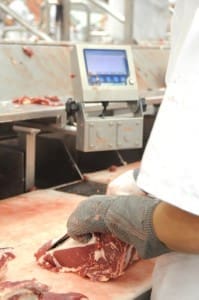WET weather again impacted on beef processing throughput last week, compounding underlying problems with cattle supply.
 The five eastern states monitored by the National Livestock Reporting Service logged a tally of 120,800 for the seven days ended Friday, only marginally improved from the previous week.
The five eastern states monitored by the National Livestock Reporting Service logged a tally of 120,800 for the seven days ended Friday, only marginally improved from the previous week.
New South Wales was worst affected by the weather disruptions, falling 10pc on the previous week to 22,700 head – back 38 percent on this same period last year.
Queensland’s tally last week (68,900) actually lifted 7pc, but part of that can be attributed to a return to double shifts (albeit it only four days a week) at the nation’s largest JBS Dinmore plant, after a fortnight where only a single four-day shift was scheduled.
As predicted earlier, September is already proving to be barren ground for slaughter cattle supply, with several large Queensland sheds, including NH Foods at Oakey, making the tough decision to cancel Monday shifts for the entire month, to try to get by until a little later into spring when better numbers will hopefully start to re-emerge.
In southern states, Victoria’s kill last week reached 19,600 head, down 20pc on this time last year, while South Australia was 6651 head, back 30pc. Tasmania’s kill fell below 3000 for the week due to rain disruptions, back 20pc on the previous week.
Saleyards this week are also reflecting the rain impact, with Wagga’s numbers falling away yesterday to just 2000 head, and AuctionsPlus, Dubbo and Wodonga last week also impacted.
Meatworks direct consignment grids are largely unchanged again this week, with quotes for southern Queensland slaughter in coming weeks still at 560-570c/kg for four-tooth grassfed Jap ox, and best cow money of 510-520c/kg.
Last week’s wet weather probably only stalled what now looks like an inevitable grid adjustment, one market watcher suggested.
Processors appear content to hold tight on current pricing, electing to simply kill less cattle at current price levels, rather than chase cattle further in a rain-affected supply market.
Compounding the problem in coming months is growing evidence that cattle on feed are starting to drop away significantly. There’s no shortage of evidence now that feedlots are starting to empty out, through lack of profitability, as exposed in our 100-day breakeven report last week.
One of the largest lotfeeders in the country, with multiple large yards across eastern states, tells us their stock inventory is now back about 18 percent on where it sat earlier. Plenty of other yards have provided Beef Central with similar feedback in the past weeks, meaning the grainfed supply is likely to tighten considerably heading into Christmas.
For grass cattle, the late start since June-July rain started has delivered a late oats season, and many cattle are still perhaps six weeks behind where they would otherwise be, weight-wise.
Additionally, vendors are wary about pushing cattle to market in the knowledge of what they have to pay in current market conditions to buy in young cattle as replacements.
Grids for plants killing both grain and grassfed cattle display a grainfed premium currently of only about 10c/kg dressed weight, providing little real incentive to chase a ‘GF’ cipher on a carton.
Bid the grid offers signals
Evidence of that came in yesterday’s Bid the Grid sale on Auctions Plus, where 400 grainfed ox offered by Consolidated Pastoral Co made little better than grassfed money. The steers, being custom-fed at Smithfield near Proston sold for 570c-580c/kg against the grid. A line of grainfed heifers 266kg estimated dressed weight, 20-36 months also made 570c.
Current spot grid on similar cattle is 585c for southern Qld slaughter.
The three pens initially were passed in at 560c, suggesting export processor buyers were hesitant about speculating about pricing for October week four grainfed kills.
Similarly, there were two very large lines of grassfed export bullocks – each 400 head – from S.Kidman & Co, ex Durrie near Bedourie in far western Queensland in yesterday’s Bid the Grid sale.
Offered for delivery after October 14, the steers (avg 323kg dressed weight, 36-48 months. mostly four or six teeth) made 529c/kg on-property (buyer pays the freight).
Work on $105/head freight from Bedourie back to major plants in southern Qld ($40/head road, then $65/head rail) and it adds up to an extra 35c/kg to land the cattle at-plant. That values the steers at 564c/kg landed, before normal grid discounts apply.
All this suggests that export processors are starting to anticipate a correction in price by October, it seems.
